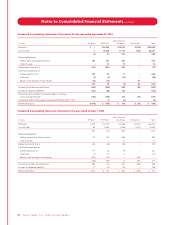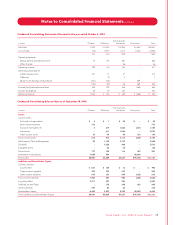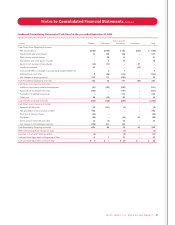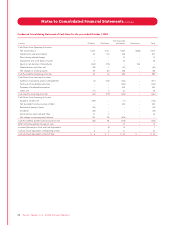Tyson Foods 2006 Annual Report Download - page 35
Download and view the complete annual report
Please find page 35 of the 2006 Tyson Foods annual report below. You can navigate through the pages in the report by either clicking on the pages listed below, or by using the keyword search tool below to find specific information within the annual report.
locations. The Manchester operation employed approximately 550
employees and primarily produced sandwich meat for foodservice
customers. The Augusta facility employed approximately 170 employees
and produced hot dogs, sausages, boneless hams and deli turkey
products. These locations ceased operations in fiscal 2004. As a
result of this decision, the Company recorded total costs of $24 mil-
lion in fiscal 2004, which included $4 million of costs related to
closing the plants and $20 million of estimated impairment charges.
The costs for closing the plants included $2 million of employee
termination benefits and $2 million of other plant closing related
costs. These amounts were reflected in the Prepared Foods seg-
ment’s Operating Income (Loss) and included in the Consolidated
Statements of Operations in Other charges. The Company has fully
paid its employee termination benefits and other plant closing
costs. No material adjustments to the total accrual are anticipated
at this time.
NOTE 4BSE-RELATED CHARGES
On December 23, 2003, the USDAannounced a single case of BSE
had been diagnosed in a Washington State dairy cow. The effect on
the Company’s Beef segment caused by that announcement, along
with the decision of various countries to restrict imports of U.S.
beef products, resulted in the Company recording BSE-related
pretax charges of approximately $61 million in fiscal 2004. These
charges were included in cost of sales and primarily related to the
decline in value of finished product inventory destined for interna-
tional markets, whether in-transit, located at the shipping ports or
located within domestic storage, as well as live cattle inventory and
open futures positions. No material adjustments were made subse-
quent to the initial BSE-related accruals recorded in fiscal 2004.
NOTE 5FINANCIAL INSTRUMENTS
The Company purchases certain commodities, such as grains, live-
stock and natural gas, in the course of normal operations. As part of
the Company’s commodity risk management activities, the Company
uses derivative financial instruments, primarily futures and swaps, to
reduce its exposure to various market risks related to these purchases.
Generally, contract terms of a financial instrument qualifying as a
hedge instrument closely mirror those of the hedged item, provid-
ing a high degree of risk reduction and correlation. Contracts
designated and highly effective at meeting the risk reduction and
correlation criteria are recorded using hedge accounting. If a deriva-
tive instrument is a hedge, changes in the fair value of the instrument
will be offset either against the change in fair value of the hedged
assets, liabilities or firm commitments through earnings or recog-
nized in other comprehensive income (loss) until the hedged item
is recognized in earnings. The ineffective portion of an instrument’s
change in fair value will be immediately recognized in earnings as
a component of cost of sales.
The Company had derivative related balances of $11 million and
$117 million recorded in other current assets at September 30, 2006,
and October 1, 2005, respectively, and $23 million and $125 million
in other current liabilities at September 30, 2006, and October 1,
2005, respectively.
• Cash flow hedges: The Company uses derivatives to moderate
the financial and commodity market risks of its business operations.
Derivative products, such as futures and option contracts, are con-
sidered to be a hedge against changes in the amount of future cash
flows related to commodities procurement. The Company also
enters into interest rate swap agreements to adjust the proportion
of total long-term debt and leveraged equipment loans subject to
variable interest rates. Under these interest rate swaps, the Company
agrees to pay a fixed rate of interest on a notional principal amount
and to receive in return an amount equal to a specified variable rate
of interest for the same notional principal amount. These interest
rate swaps are considered to be a hedge against changes in the
amount of future cash flows associated with the Company’s
variable rate interest payments.
The effective portion of the cumulative gain or loss on the deriva-
tive instrument is reported as a component of Accumulated Other
Comprehensive Income (Loss) in Shareholders’ Equity and recog-
nized into earnings in the same period or periods during which the
hedged transaction affects earnings (for grain commodity hedges,
when the chickens that consumed the hedged grain are sold). The
remaining cumulative gain or loss on the derivative instrument in
excess of the cumulative change in the present value of the future
cash flows of the hedged item, if any, is recognized in earnings dur-
ing the period of change. Ineffectiveness related to the Company’s
cash flow hedges was not significant during fiscal 2006, 2005 or 2004.
Ty s on Foods, Inc. 2006 Annual Report33
Notes to Consolidated Financial Statements continued
























